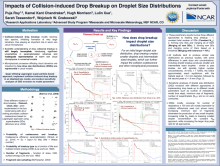Impacts of Drop Breakup on Droplet Size Distributions using Lagrangian Superdroplet Method in Idealized Box Model Simulations
Puja
Roy
NSF NCAR ASP Postdoctoral Fellow (RAL/EdEC)
Poster
Cloud microphysical processes that influence cloud dynamics are impacted by how raindrop size distributions (RSDs) are represented in numerical cloud models. Collision-induced drop breakup is considered to be the key mechanism inhibiting the formation of very large raindrops and modifying raindrop size distributions. However, scientific understanding of drop collisional breakup is still largely incomplete, which introduces significant uncertainties in parameterization schemes and inadequate representation of warm rain cloud microphysics in numerical models. In this study, we investigate the impact of drop breakup on evolution of drop size distributions (DSDs) by implementing drop breakup parameterization schemes within an idealized zero-dimensional box model. The model represents drop breakup in three different modes – filament, sheet, disk, along with all-or nothing stochastic collision-coalescence based on a Lagrangian approach. Lagrangian particle-based approaches have become increasingly popular over the last few years owing to certain capabilities over the traditional Eulerian based bulk and bin microphysics schemes, including better representation of influence of sub-grid scale variability and elimination of numerical diffusion. Results from this study will include sensitivity analyses of drop size distribution evolution to a wide range of modeling parameters such as number of super droplets (NSD), model time steps, number of realizations, initial DSD parameters, number concentrations of droplets, different superdroplet initialization methods, and more. This study will also investigate whether drop size distributions reach equilibrium in the presence of both coalescence and breakup in these idealized box model simulations. These numerical experiments will provide valuable insights for improving the implementation of drop breakup in higher dimensional models such as CM1-LES.

M2M_Poster_2024_Puja_Final (1).pdf
(2.31 MB)
Meeting homepage
